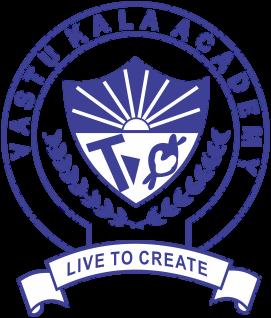Improving the potential of Ecotourism in Kerala by practicing SustainableArchitecture
Abstract: Ecotourism is a form of tourism that has been gaining more popularity because of increased sensitivity towards nature among people. Ecotourism is the most complete form of sustainable tourism. It means responsible travel to natural, pristine, andprotectedareas,conserving the environment and culture, and improving the well-being of the local people and local economy Kerala is oneofthefastest-growingstatesofthecountryintermsoftourismandhasbeenapplauded over the decades for its sustainable tourism model. The state boasts of 56 ecotourism spots andis working towards their protection, and local & tourist awareness.Theaimofthisstudyistoidentify and improve the relationship between ecotourism & architecture, the factorsthatexertinfluenceon this interaction, and uncover the knowledge gap in relevant policies and strategies for the development of ecotourism and its relatedarchitecturethroughsustainablestrategies. Thecoreidea of ecotourism lies in architecture asithasthepowertoexpresstheenvironmentandculturethrough space. This study uses different methods of research to establish and analyze its aim and discover new possibilities for ecotourism with the help of architecture. Qualitative andquantitativemethods of research have been used to establish the meaning of ecotourism, sustainability, andarchitecture. The researchisexploratoryanddescriptiveinnature.Twotypesofsurveyshavebeenusedtocollect data for analysis - Closed surveys and open-ended surveys along with one-to-one interviews. Through such methods, the research critically reviews the status&ecotourismpoliciesinKerala.It establishes the need for mindful design interventions to support the infrastructure required. Use of locally sourced natural materials, passive solar and energy-efficient strategies, improving cultural identity throughspace,andminimalenvironmentalimpactaresomeofthewaysinwhichdesigncan make ecotourismbetter Eventually,thiswillhelpgeneratemorelocalemployment,foreigncurrency inthelocalcommunities,andstate,cultural,andenvironmentalawareness.
Keywords: Ecotourism, Kerala, Sustainable architecture, Vernacular Architecture, Community development,Conservation
1.Introduction
1.1Ecotourism
The environmental movement of the 1970s gave birth to ecotourism and other types of sustainable travel. Ecotourism did not become a popular vacation concept until the late 1980s. Increasing environmental consciousness and a desire to travel to natural settings rather than developing tourist destinationsmadeecotourismappealinginrecenttimes
Ecotourism is a type of tourism that involves visiting fragile, pristine, and largely undisturbed natural regions, with the goal of becoming a low-impact, small-scale alternative to traditional commercialmasstourism.
Eco-tourism is the most complete expression of sustainable tourism. It necessitates going to natural regions responsibly, saving the environment, and enhancing the well-being of the locals It typically involves travel to destinations where flora, fauna, and cultural heritage are the main attractions Its goal is to provide visitors with a better understanding of how humans affect the environment and to encourage a greater appreciation for our natural surroundings.Ecotourismhasthepotentialtochange the attitude of its host society toward the environmental, social, andeconomicissuesthathavearisen asaresultofcapitalism'sdevelopment
CollegeofArchitectureVastukalaAcademy:ResearchPaper2020-21
Riya Kumari/ Improving the potential of ecotourism in Kerala by practicing sustainable architecture
Thebroadgoalofecotourismistocreateexperiencesthatbenefiteveryone,notjustthetourists& stakeholders.Thisincludesprotectingthelocalecosystemandnaturalresources.Italsoinvolves givinglocalpeoplealivingwagewhilehelpingthempreservetheircommunitiesandculture While thegoalissimple,theexecutionisnot Therearemanyfactorsandopposingneedsthatareinvolved Tomakeiteasier,thisisasetofneededcriteriaforachievingecotourism
Economical&culturalawareness
One of the main goals of ecotourism is to increase the awareness tourists have about the social and economical conditions surrounding a travel destination Ecotourism aims to expose tourists to the realities of an area Ecotourism educates travelers on the interdependent relationship between conservation,sustainability,builtinfrastructure,andthereal-lifeoflocalcommunities
Benefitforthelocalcommunity
Thenextgoalofecotourismisthatitshouldbebeneficialtothelocalcommunity.Thewayofdoing thisisbydonatingsomeoftheprofitbacktothelocalcommunityandbyemployingthelocalpeople ininfrastructureprojects Obviously,theirbasichumanrightsshouldberespected
Benefitfortheenvironment
Theecotourisminitiativeshouldhaveaclearbenefitfortheenvironmentaswell.Partoftheprofit generatedbytheecotourismcompanies/resorts/centersshouldgointonatureconservationefforts.The activities,structures,andaccommodationsmadeshouldalsoleaveaminimalcarbonfootprintonthe earth Usingsustainablematerialsandsourcesofenergyisonewayofachievingthis
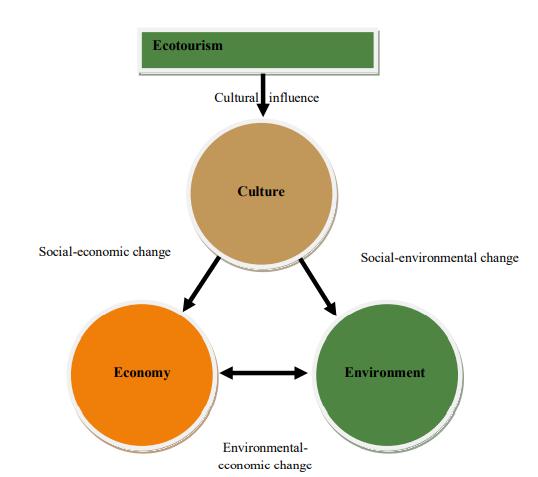
Humanrightsanddemocracy
Ecotourismshouldalsostrivetosupporthumanrights,economicempowerment,anddemocratic
Figure1:Relationshipbetweenecotourism,thecultureofthehostsociety,environment,and economicsystem
movementsinhostcommunities.Thispoliticalaimofecotourismisthemostcontentiousandoften thehardesttodefineclearly.
Figure2:Theperceivedrelationshipbetweensustainability,mass tourism,alternativetourism(AT),andecotourism
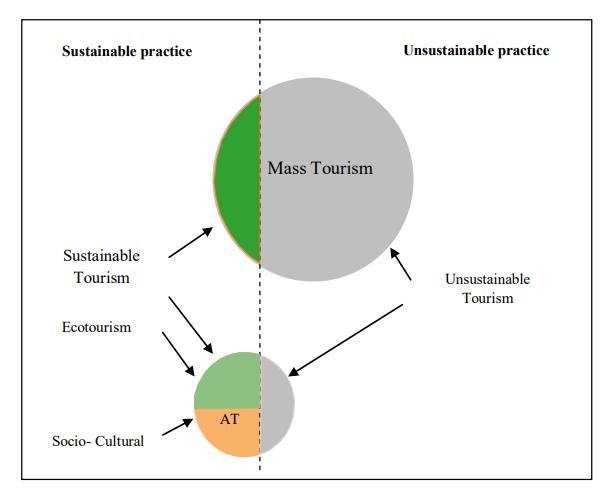
People universally think that ecotourism is fast developing, according to a survey done by The International Ecotourism Society (TIES, 2015) Only 4 out of 971 respondents, or less than 05 percent, believed ecotourism was slowing The rest agreed that ecotourism is on the rise, and it's on the rise quickly Travel agents, travelers, tourism officers, researchers, tour operators, media and marketing workers, hotel and attraction owners/managers, students, non-profit organizations, and national/international tourism boards from all over the world were among the participants interviewed
EcotourisminIndia
Accordingtoasurveyconductedbyaleadingtravelcompany,97%ofIndianswanttotravel sustainablyandtoensureaslowanimpactontheenvironmentaspossible.
● ThesustainableactivitiesenjoyedbyIndiansarebuyinglocallymadeproducts(69%),
● Usingpublictransportinsteadofataxi(62%),
● Andeatinglocalfood(61%)
About75%feelmotivatedbynaturalsightsincludingbackwaters,coralreefs,rainforests,andalsothe impactofecotourismonthelocalcommunity
1.2EcotourisminKerala&itspolicies
Riya Kumari/ Improving the potential of ecotourism in Kerala by practicing sustainable architecture
Kerala is an Indian state located in the southwest region of India on the Malabar coast having a diverse coastline of 580 km. The state has everything from deep forests, backwaters, and pristine waterfalls,tohillstations Itismostlyknownforitsdestinationsandscenicbeautyfortourists
It is an excellent example of ecotourism becauseitwasbuiltaroundboathouses,templearchitecture, and scenic beauty The most well-known of these are Kerala's boat homes, which have boosted the economy while simultaneously preserving the nature of the backwaters of Alleppey, Alappuzha, and other areas. Kerala ecotourism strives to provide visitors with an understanding of the local culture, flora and animals, and environmental conservation With each passing day, ecotourism, along with pilgrim, backwater, and village tourism, is boosting this area tonewheights Withtwonationalparks and 12 animal sanctuaries, it covers a protected area of 2,324squarekilometers Thedevelopmentof ecotourism in Kerala's the Western Ghats, with its tropical forest ecology, offers tourists a natural advantage. Kerala’s tourism industry isoneofthekeycontributorstothestate’seconomy.Changesin the market forces as well as move toward environmentallysensitiveandsustainableformsoftourism offerthemaximumpotentialforthepromotionofecotourisminKerala
Kerala tourism follows a sustainable tourism model adopting various suitable parameters. Kerala believes in qualitative tourism attracting a limited number of visitors whoarehighspendersandwho value local culture, community, and environment. Kerala has been awarded for its sustainable ecotourism policies by the UN and is soon to be declared the worldleaderinresponsibletourism in2022.
TheWorldTourismOrganizationhasdesignated Thenmalaasapremiereco-friendlyprojectin Kerala. It is India's first planned Ecotourism destination.Keralatourismfollowsasustainabletourist approach that incorporates a number of appropriate parameters Kerala believes in high-quality tourism, attracting a small number of high-spending visitors who appreciate the local culture, community, and environment. Kerala is India's ecotourism leader, and it's setting agreatexamplefor the rest of the country Kerala has also been recognized by the United Nations for its sustainable ecotourismregulationsandissettobenamedtheworldleaderinresponsibletourismin2022
In Kerala, 56 locations have been recognized as potential ecotourism destinations (Figure3), with a focus on conservation, ecological sustainability, environmental education, and local community benefits. A dedicated eco-tourism wing has been established to provide policy assistance for the development of the state's eco-tourism hotspots. The state’s ecotourism model states therequirement of eco-sensitive resorts, ecotourism centers, backwater resorts, deep woods environmental educationcenters,interpretationcenters,etc
There is quite clearly an imbalance between the geographical spread of tourism assets and tourism development While all varietiesoftourismassetsarespreadoutfairlyuniformlyacrossdifferentparts of the State, the more popular tourist destinationsareconcentratedinthesouthernandcentralregions NorthKeralareceiveslessthan5%oftotaltouristarrivalstotheState.
Kerala’s Tenth Five Year Plan proposals for tourism suggest the following broad patternofallocation acrossdifferentregionsoftheState:
1 SouthernKerala(Thiruvananthapuram,Kollam,Pathanamthitta&Alappuzhadistricts) : 40%
2 CentralKerala(Kottayam,Idukki,Ernakulam,Thrissur&Palakkaddistricts) : 45%
3.NorthernKerala(Malappuram,Kozhikode,Wayanad,Kannur,andKasaragoddistricts): 15%
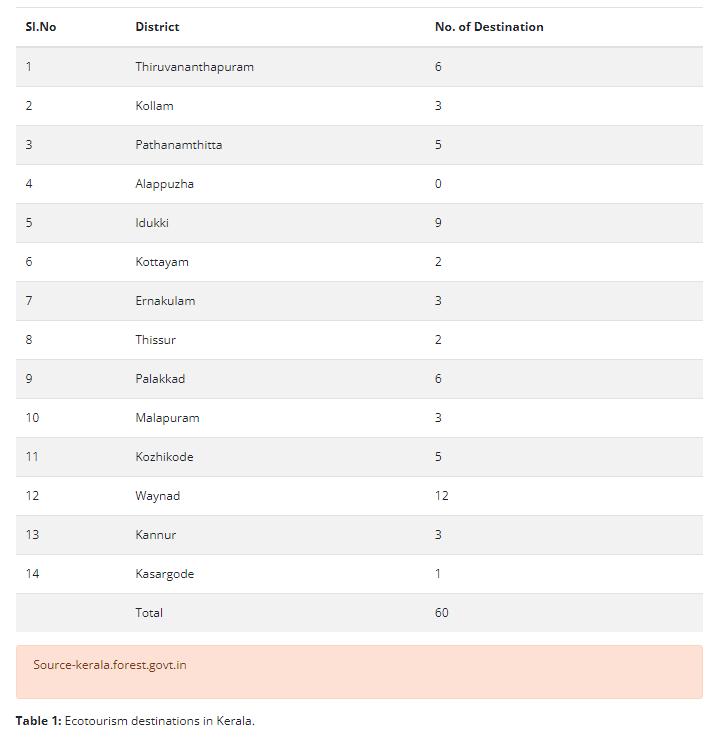
Clearly,NorthKeralacanhelpinreducingthedamagingeffectsoftourismbybalancingthefootfallby building eco-infrastructure there. Low-densityresortsandotherdevelopmentscantakeplaceprimarily intheinteriorhighlands
Afewofthe Keralagovernment’spoliciesfor2025 arementionedbelow:
a Quite clearly, all new tourist facilitiesshouldbecreatedoutsidetheprotectedareaboundaries Thiswouldeliminatetheprimecauseofconflict.
b Tourism in forest areas is pronetobeecologicallysensitive,andonehastotreadwithcaution,
Riya Kumari/ Improving the potential of ecotourism in Kerala by practicing sustainable architecture
with continuous monitoring of the costs and benefits. Further, forest and wildlife-based tourism would have to be encouraged on a conservative level, and therefore cannot be expectedtogeneratelarge-scaleemploymentandincomegeneration
c. As Kerala is an ecologically sensitive state, appropriate pollution control norms must be formulated at the state level in association with the State Pollution Control Board, so that all tourism projects of significant magnitude are brought under scrutiny Implementationofthese norms may be accompanied by a system of local-level participation and public hearing for clearing projects that are above a certain scale. This will ensurethatonlyprojectsappropriate to a given place are set up, thus addressing issues of economic, socio-cultural, and ecological/environmentalimpactsinonego.
d. The numbers and quality of facilities would have to be regulated, keeping in view the local carryingcapacityindifferentplacesoftouristconcentration.
e. Minimizeadversesocio-culturalandenvironmentalimpactsoftourism.
f Safeguardthesecurityandhealthofthehostpopulationandalsothoseofthetourists
g Integrate with the overall development objectives of the State, and promote balanced development,withoutcreatingover-dependenceontourism
h. Disperse economic development, to the extent applicable and possible, to the less developed regionsoftheState
1.3Sustainablearchitectureanditsrelationwithecotourism
Architecture has the potential to express environment and culturethroughspace,whichiswhyitisat the heart ofecotourism Architectureandtourismaretwoactivitiesthatarestronglylinked Theyboth rely on one other in some way. As a result, the study's goal is to evaluate Kerala's eco-tourism potential by employing sustainable architecture and design. To reduce the environmental impact of tourism by thoughtful interventions utilizing context-oriented architecture The architecture supports ecotourism because it blends in with the environment and conveys the local unspoiled life through a user experience It aids in raising awareness of existing resources, craftsmanship, and culture of a certainlocation,aswellassupportingtheeconomicsandidentityofthearea.
Architecture is viewed as one of the ecotourism products that can contribute to sustainable development through ecotourism.Inaddition,architectureispartofthesocialproductsthatcontribute to the interaction between society and its surrounding environment towards being sustainable throughusingspaces,materials,andrenewablesourcesofenergyinasustainableway.
The main cultural outcomes for architecture used as one of the ecotourism products are the same as the anticipatedculturaloutcomesforsustainabledevelopmentofecotourism. Theseoutcomesinclude awareness of people about their cultural and environmental capitals and heritage and engagement of local people in the sustainable development process through the architecture used in ecotourism development
Vale and Vale (2009:10) discuss the two models for portraying the meaning of sustainability; the ‘weak model’andthe‘strongmodel’ofsustainability AccordingtoValeandVale(2009:10)inthe weak model of sustainability, the three main components of sustainable development, the environment, human society, and the economy are represented by three intersecting circles of equal sizeandvalues.
In the weak model of sustainability (Figure 41), the three main components are portrayed as competing interests so that the degradation of one can be compensated for by the improvement in another In the strong sustainability model, as explained by Vale and Vale(2009:10)theenvironment is considered as a circle in which society as a base for human activities is set (Figure 4.2). In this model, the environment is considered as the main foundation, which strongly exerts influences on society,culture,andalltheirsubsectorssuchastheeconomy,architecture,politics,art,etc
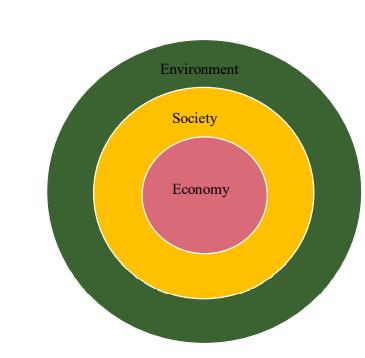

1.4Knowledgegap
Since the term “Ecotourism” has become very popular recently, it is being overused and misused in numerous cases, many pseudo-eco tours are being set up, pretending to be “greenoperations”,butin reality, they are only seeking profit, without engaging in no real environmental consciousness In othercases,projectswiththeintentionofbeing“ecotouristic”havefailedbecausethetrainingaspects were neglected, the active involvement of the local communities was not achieved, local landscape and ecology were not preserved, orforanumberofotherreasons.Noteverythingaboutecotourismis on the bright side. There are some problems as well. Many tourist “mega-projects” continue to be rampant in many countries, especially in beach environments,withtheirwell-knownravagingeffects on the natural andculturalenvironment OneexampleisthepristinebeachesofLakshadweepIslands, India But genuine, well-planned ecotourismprojectsaredefinitelybecomingmoreandmorerealand popular everywhere, and hopefully, they will establish new trends for the 21st century, in which all humanactivitieswillhavetobeofasustainablenature.
A knowledge gapalsoexistsintermsofframeworksandstrategiesforthesustainabledevelopmentof ecotourism and its related architecture This knowledge gap can be further described as a lack of a comprehensive framework that has the ability to integrally consider the ecological, cultural, and economic influences exertedbyecotourismanditsarchitectureonagivenhostdestination.Moreover, there is a deficient link between expected activities and each forecasted outcome and an absence of
Figure4.1WeakModelofSustainability Figure4.2Strongmodelofsustainability
Riya Kumari/ Improving the potential of ecotourism in Kerala by practicing sustainable architecture efficient cultural and economic indicators that can be used to evaluateecotourismandarchitectureas beingculturallyandeconomicallysustainable.
2.CaseStudies
This research paper uses three case studies, namely, Banasura Hill Resort, Wayanad; Ulaman Eco Resort, Bali; Ecotourism Centre, Franchard biosphere Reserve, France to understand the study and analyze the existing ecoresorts in Kerala and what sustainable measures they take to contribute towardsthesocial,economical,ecologicalandenvironmentalaspectsofecotourism.
2.1BanasuraHillResort,Wayanad
Banasura Hill Resort is a nature resort in the Wayanad District of North Kerala, India It stands on a 35 acres (14 ha) plot amidst the mountains of the Western Ghats declared as one of the traditionally preserved sites in the worldbyUNESCO.
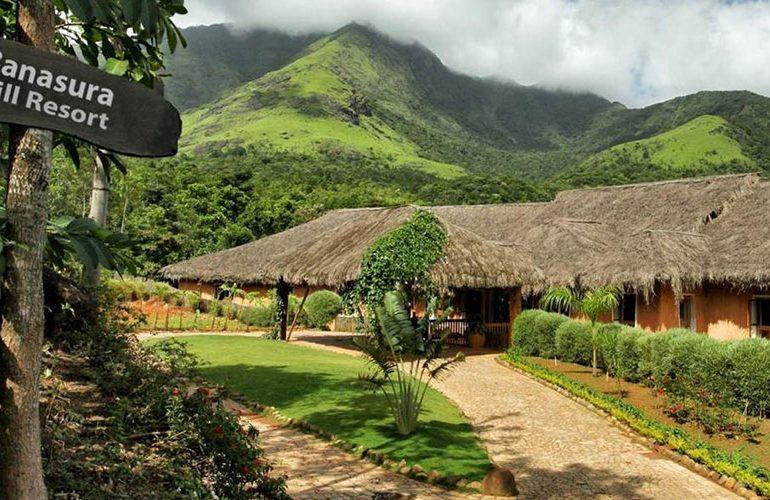
The resort’s architectural design follows construction based on reusable natural materials and the major material is rammed earth. It is made of 95% mud and only 5 % cement has been used to stabilize the mud. The living structures within the resort complex are constructed using mud excavated from the site on which it stands The main building hasanareaof nearly 20,000 square feet spread over two floors (31 rooms, huts, suites, restaurant, coffee shop, conference hall, Ayurvedic spa, Reception, library, gym, STP, Bio-gasplant)andismadeentirelyout of mud, with a lightweight roof of bamboo and coconut palm fronds. Local tribes were called in for laborandtheirexpertiseinbuildingwithmudwasalsotapped.
“The basic concept is that there should be no damage to the environment in any manner Whatever material is used for construction should return to earth after lifecycle without damaging the environment.”(EugenePandala,2010)
No air conditioning is needed as the mud walls aregoodregulatorsofheatandcold.Thesestructures can balance fluctuation in the temperatures throughout the year. Recycled wood has been used for muchofthewoodwork.Curvaceousformshavebeenusedtocorrespondthetoexistinglandscapeand terrain of the site Planning is done in a way that the window openings are infrontofeachotherand allow for cross ventilation Smaller inlets paired with larger outlets increase wind velocity in the interiorspace Largetreeshavebeenplantedalongthewindowstoavoidtheharshlow-anglesun
Located in Bali, this wellness eco-resort has been integrated into a forest that borders lushricefieldsononesideanda river on the other The river converges water from the whole area creating a junction of small waterfalls that produces enough flow to power a hydroelectric generator that can sustain the power of the buildings within the complex.
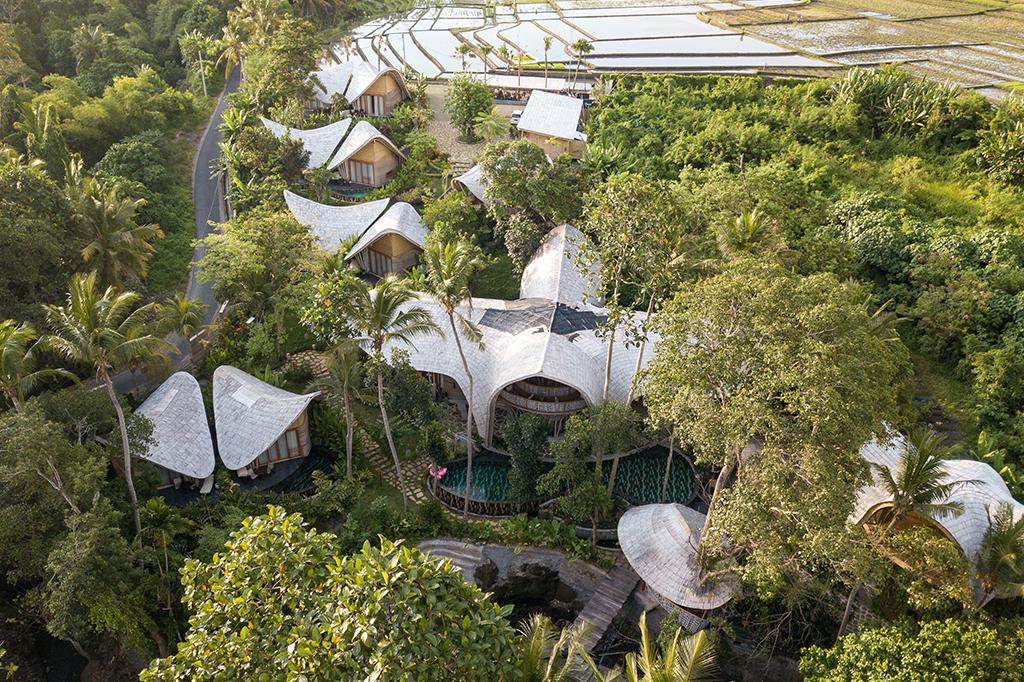
The approach to the design has been to merge with nature, not just by its operation but by using materials found directly on the site and the immediate locality, therefore makingtheresortfullycarbonzero.
This resort Utilises bamboo structures sustainably harvestedfromnearbyareaswithnowaste&use of recycling. The walls are made fromrammedearth,recycledwoodhasbeenusedforroofing,and bamboo for the rest of the structure. All materials are locally sourced with a low carbon footprint. Theymaintainthenaturalenvironmentdesignedtoaccommodatetheexistinggreeneries.
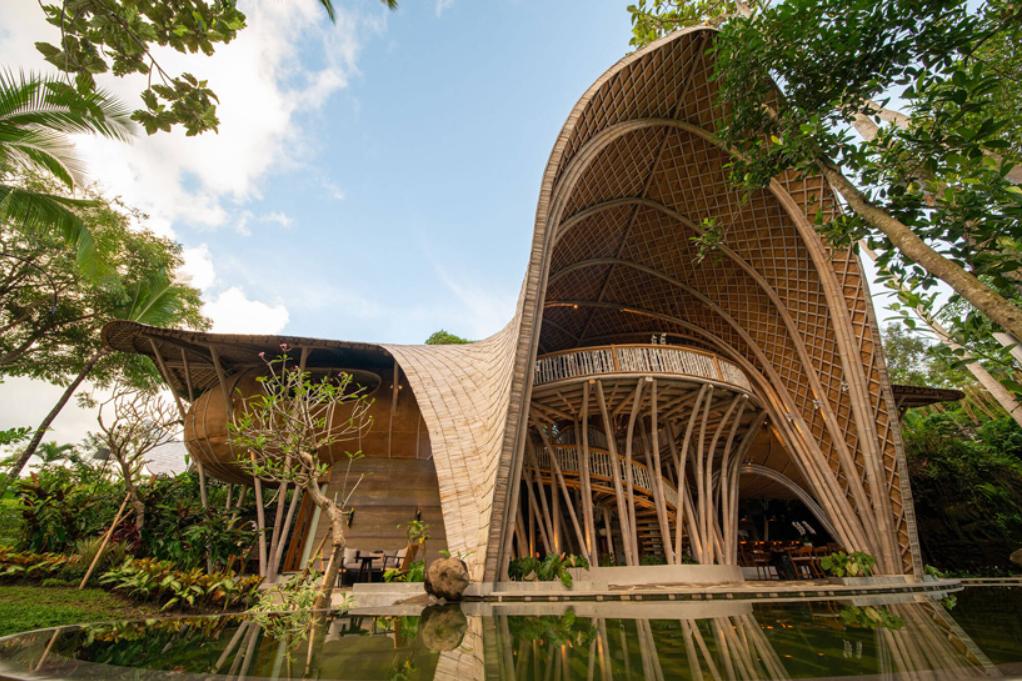
They have preserved the Balinese culture andpeoplefromthevillagework in the resort. Induced natural ventilation technique has been used by giving openings in the roof arch thatallowsfor hot air to rise keeping the interior cool Open interior spaces with minimal partitions allow for cross ventilation at body level. Water bodies around every structurehelpindaytimecooling
The site the “gorges de Franchard” is the mostpopularamongtheforestmassifofFontainebleau(the biggest listed site in France) This very sensitive site is ofhighqualitywithinthenewnaturereserve The very first Eco-tourism center within the île de France’s goal is the better management of the trafficflowoftheareaasmuchasthepublicawarenessofitsgreatfragility
2.2UlamanEcoResort,Bali
2.3EcotourismCentre,FranchardBioreserve,France
Riya Kumari/ Improving the potential of ecotourism in Kerala by practicing sustainable architecture
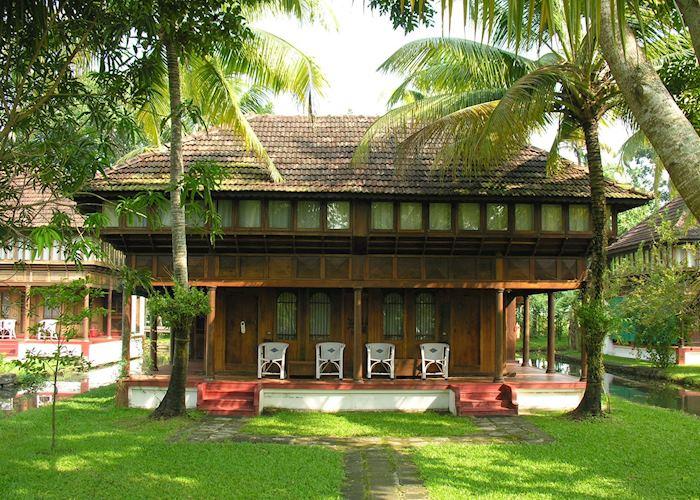
Oriented to optimize solar gain and keep the structures warm without undue mechanical help, the center is organized around a reception and exhibition area and a hall where educationalactivitieswillbeheld.
The building is thought of as a living room in the woods Its wide and smooth shapes gently wandering along the preserved trees are inspired by the eroded stones seen on the site As a true dialogue between architecture and nature, the project draws new boundariesbetweenpubliclyaccessiblegroundsandfragileforestsoilwithlimitedaccess

Theorientationchoicesandtheprotectionfromthemainwindsoptimizethebioclimaticsolutions andtheeco-friendlyenergysourcesused Theuseof woodanditsimplementationgivesthe opportunityforeco-constructionsolutions. Superficialfoundationsensuretheproject’sreversibility. Thecomfortableandfunctionalspaceoffersahighdegreeofflexibilitydependingontheseasonand theattendancerate.
Itlooksneat,butinadditiontousingmaterialsfromsustainableandnon-toxicsources,thereshould havebeenagoaltominimizetheamountofmaterialneeded,andtomaximizetheusefulspacesuch thatthereisnospacewastage.Alotofthesedesignslookgood,buttheyalsohavealotofwasted space,nooksthatbecomeunusable,andthus,extramaterialthathasgonetowaste.
3. ArchitecturalMeasuresforEco-SensitiveDesign
From the literature study and case studies, different sustainable strategies and materials have been found common and successful in designing an eco-sensitive sustainable structure, especially for Kerala. These strategiesandmaterialswhenincorporatedintothedesignwillresultinminimalimpact onthesitefloraandfauna,habitatsofanimals,andthenaturalterrainofthesite.
3.1SustainableStrategies/Techniques
• Orientation of smaller side of structure along with the east-west direction
• North-southorientationformax airmovement
• High density of façade that is
openandyetshaded.
•Faint/palecolorsonoutersurfaces
•Buildingmaterialswithinsulating/reflectingpropertiesthatresistheattransfer
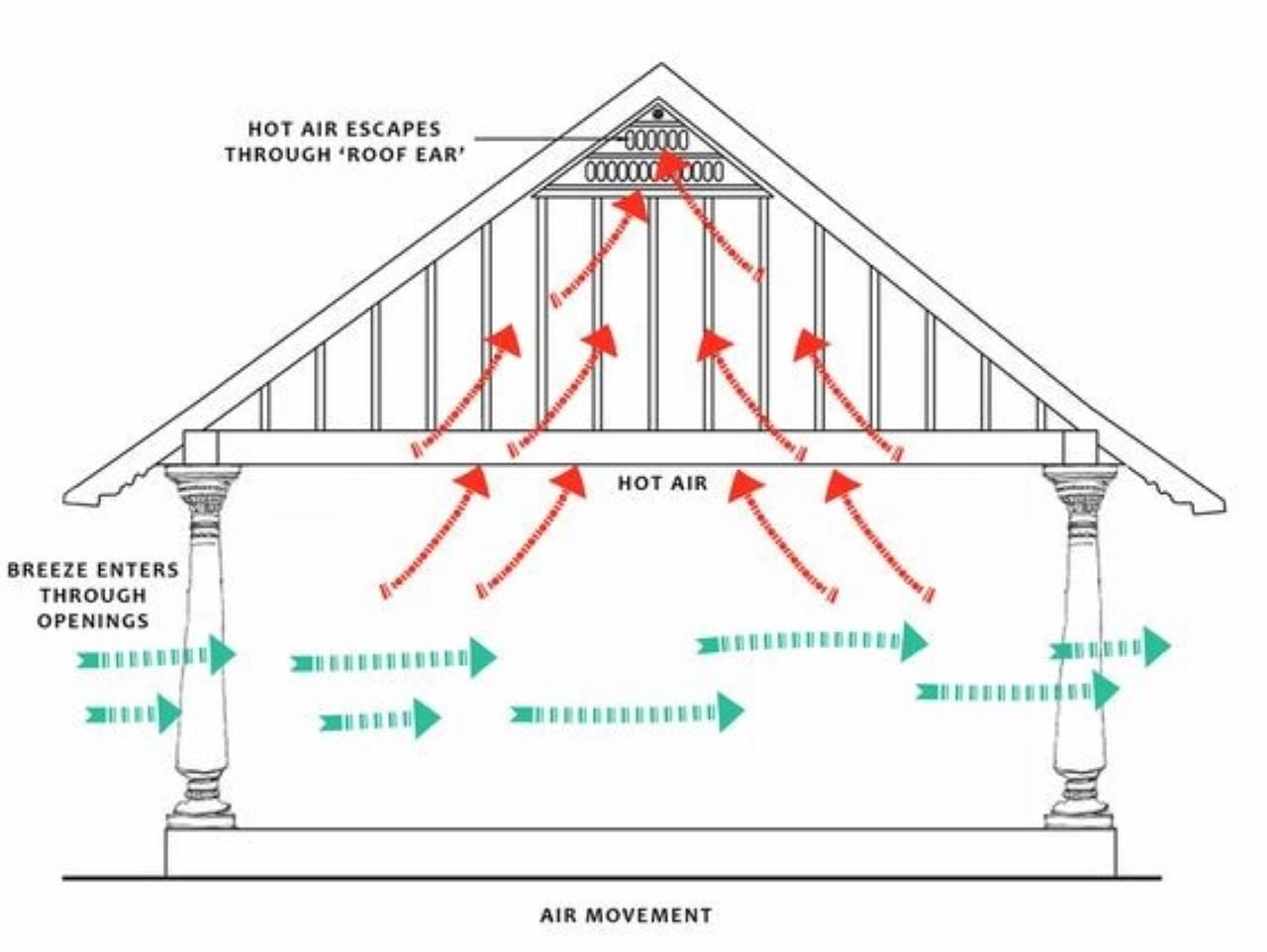
b. RoofingPattern:
•Voids in roofs and courtyards provide max. light and cross ventilation with large openings to catchthebreeze
•Light colors, natural materials, and reflective surfaces on roofs will deflect solar radiation and keepthebuildingcool
•Sloping roof is a characteristic of these regions as it drains off rainwater
•Barrel-vaultedroofcanalsobeseen
c. Crossventilation:
• Being in atropicalclimate,cross ventilation plays an importantrole in creating comfortable spaces The presence of high moisture content in hot air causes discomfortfortheuser
• Courtyard spaces are extensively used in houses of Kerala of all scales It helps in achieving passive cooling and reduces the dependence on HVAC systems. It also helps to induce continuousairmovement.

• Openings in walls facing each other and internal partitions help in increasing cross-ventilation. Using vertical louversandlargewindowshuttershelpstoreducethermal discomfortwithampledaylight.Itcansaveupto25%ofenergycosts
d. Insulation:
● Highlyinsulatedwallstopreventconductiveheatflow
● Avoidusinghardpavedsurfacesoutside
● Wallsshouldbeoflightcolortoreflecttheheat
Riya Kumari/ Improving the potential of ecotourism in Kerala by practicing sustainable architecture
● Fillerslabs,cavitywalls,doubleroof,andcompositewalls insulatethehouse againstheat
● The materials used should be lightweight, highly reflective, and should have a low warmlimit
● It is important to insulate the roof against sunlight and heavy rain Thehighpitched roof of traditional Kerala structures maximizes pressure difference to optimize airflow.
e. SolarShading:
● Verandastoav p
● The east and west façade should be least exposedtothesuntopreventlateafternoon and early morning heat. One way is to have dense tree plantations around these façades.
● Minimumglasssurfaceshouldbeexposedtodirectsunlight
● Useoverhangs,louvers,canopies,etc forsheltering
● Shadingdevicesforwindowsanddoorstoavoidsolarheatgain
● Traditional buildings in Kerala have an internal and external verandah which acts as buffer space to reduce direct exposure to sunlight whereas the internal verandah allowslighttoenterthebuildingviaacourtyard
f. Fenestrations:
● Different fenestration elements can be oriented in the rightdirectiontomaximizethe flowofairandthusmaintainthermalcomfort
● Jaalistoinvitediffusedairandmaintainairmovement
● Skylightinthenorthernfacadetobringindaylight
● Windowswithmaximumopenablearea
● Largeventsaretoallowalotofairtopass
InthevernaculararchitectureofKerala,woodenjalis,two-panelcasementwindows,etc were used to maximize airflow The small fenestrations increased the velocity of the air and alloweditsdeeperpenetrationintheinnerspace.
g. Berms: Berms are mounds of soil that slope into the surrounding landscape. Berms have a
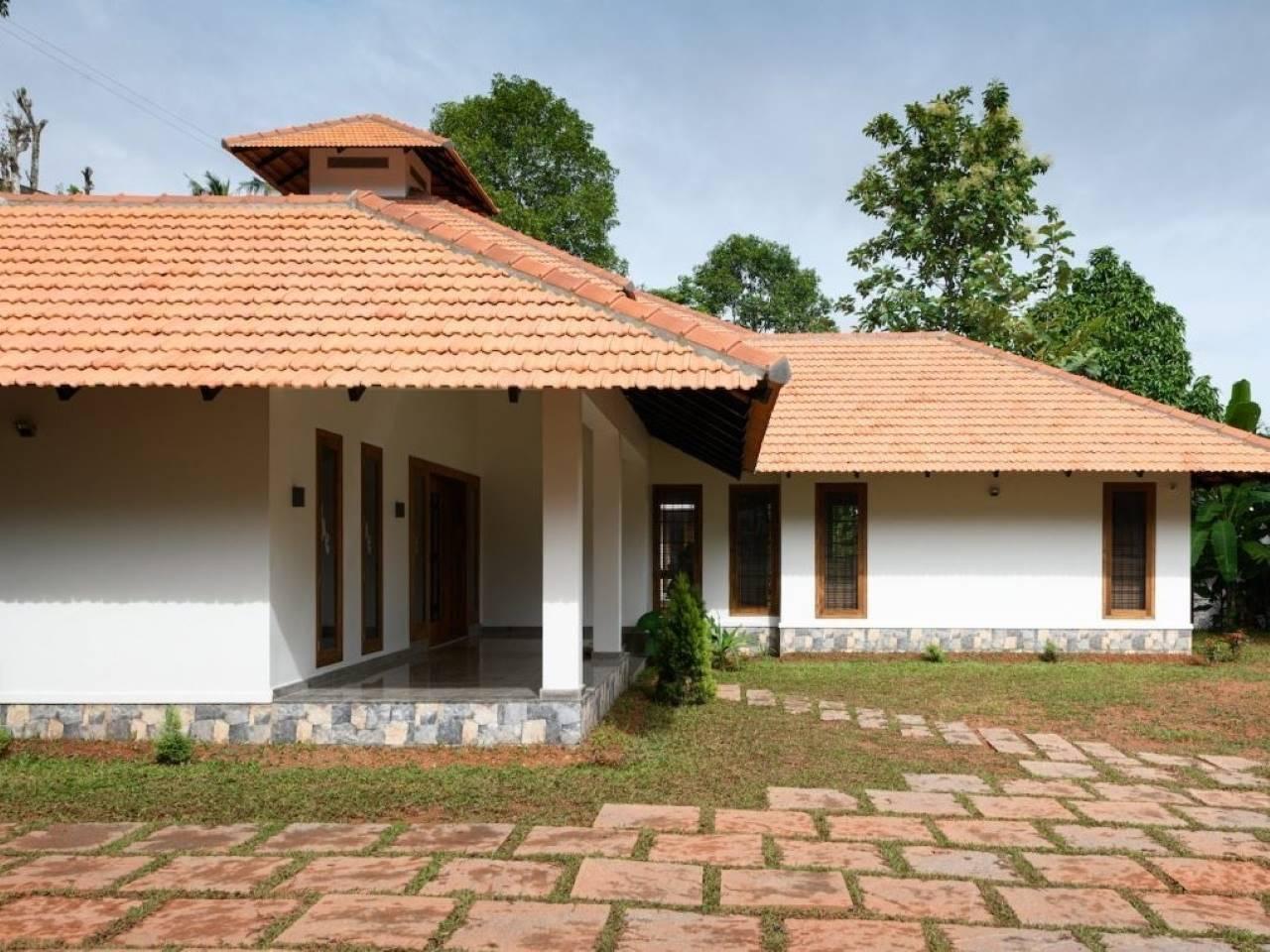
multitudeofbenefitsanduserangingfromdrainagetobeautificationoflandscapedesign.The use of landscape can integrate the built with the wider landscape with the hills or mounds. Thesebermscreateasenseofprivacyindifferentpartsofthestructure
3.2.SustainableMaterials
a. Bamboo: Bamboo has elasticity which makes it a good building material and environmentally friendly for areas with earthquakes. Bamboo has a relatively low weight andcanbetransportedeasily Bamboohasexcellentinsulationproperties “GreenSteel”-Itis very versatile, tough, and durable along with an astounding lifespan Bamboo fibers are naturally anti-bacterial so no need for any toxic chemical treatments Due to its ability to produce new culms or poles each year, when they reach four to seven years old they can be harvestedwithoutaffectingtherestoftheclump,unlikeatreethatiskilledforitswood.”
b. Mud: Mud is found in abundance in almost every part of the world This attribute makesit cheaper than any other conventional building material. - Due to the abundance, easy availability, and lesser use of energy-consuming construction equipment, it directly reduces the energy consumption The recycling of soil does not require the input of any external source Therefore, saving a lot of time and money The properties of recycled soil post-construction are the same Mud as an insulation material prevents external heat from enteringthebuildingwhilemaintainingacoolenvironmentinsidebecauseitisporous.
c. Rammed Earth: The thick walls that builders create using soil and clay can retain heat duringtheday,andthenslowlyreleaseitatnight Theyarenaturallysoundproofedbecauseof their density. Earth walls are highly durable and versatile. Provides flexibility in terms of shape, color, and finish. It is highly fire and moisture resistant. Rammed Earth has low embodied energy making it a sustainable material that reduces the structure’s overall carbon footprint It is recyclable ie can be used post demolition The construction period is longer thantheaveragetime Soilneedstobetestedbeforeforitsdurabilitybeforeusage
d. Terracotta: Terracotta is 100% natural The base material is clay, which is a naturally occurring material Terracotta construction is cost-effective The process of manufacturing terracotta is simple and natural, as it does not involve any harmful chemical treatments Terracotta can be recycled with a recyclability rate of 95 percent. Because ofitslowthermal diffusivity, i.e. it limits the heat penetration inside, the indoor temperatures are stable and comfortableinsummers Itisnon-combustibleandhasnaturalsoundabsorptionproperties
e. Palm Leaves: They’re renewable, low-carbon building materials. Theyarewidelyavailable andinexpensive,especiallyinthehumidtropics.Butitisnotagoodchoicecomparedtomore durable and less combustible coverings Skills are widely known where palm leaves are available and are easily learned Palm thatch is light inweight,sorooftimberingneednotbe very expensive Their thermal insulation value is high, so palm leaf roofs are comfortable in warm climates. This type of roof looks attractive, itblendswellwiththenaturalenvironment andisecologicallysound.
f. Laterite Blocks: One of the mainusesoflateritesforconstructionpurposesistheproduction of Compressed Earth Blocks (CEB). The production technology for CEB provides amodern
Riya Kumari/ Improving the potential of ecotourism in Kerala by practicing sustainable architecture
use of lateritic soils for wallsandmeetsthebuildingrequirementsforstructuralperformance. In addition, high esthetic quality of buildings can be achieved. In Kerala, the foundations were usually built with laterite blocks Its compressive strength can be higher than that of burnt bricks Laterite can be called the “BlessingofKerala”since80%ofthestateiscovered withit
g. Lime: Lime Allows Buildings To Breathe It is vapor permeable Porous and open-textured materials such as lime plasters, help to stabilize the internal humidity of a building by absorbingandreleasingmoisture.Thismakesforamorecomfortableenvironment.
● Limehaslessembodiedenergythancement
● Freelimeabsorbscarbondioxideinthesettingprocessofcarbonation
● Itispossibletoproducelimeonasmallscale.
● Thegentlebindingpropertiesoflimeenablefullre-useofothermaterials.
● Averylowproportionofquicklimewillstabilizeclaysoils
● Small quantities of lime can protect otherwise vulnerable, verylowenergymaterialssuch asearthconstructionandstrawbales
Its characteristics allow lime mortars to protect adjacent materials by handling moisture movements through the building fabric Lime Binders Can Be Durable And HaveStoodThe Test Of Time When used carefully, lime is exceptionally durable Local Limes Enhance Regional Identity And Diversity The diversity of limestone types provides variety and local distinctiveness. Different limes will vary in color, texture, and settingproperties.Locallimes have a regional identity, they give a sense of place and provide a continuous link with the localaesthetic
h. Straw Bale: From very early times, straw has been used as a building material: mixed with mud and clay, or as a roofing material. Straw has excellentinsulatingproperties;themassive structure of the straw bale absorbs large amounts of heat and radiates it constantly into the room This minimizes heat loss and provides a pleasant indoor climate Because the straw bales replacebricks,insulation,andfacadematerial,theresultisasimplerbuildingtechnique The basic methods can be learned in a fewdays Thisreduceslaborcostsconsiderably Since the straw is an agricultural by-product, it is cheap andavailableinmostregionsoftheworld, withlittleornotransportationcost.
i. Hemp:Itisanexcellentheatandsoundinsulationmaterial Itislightweight,fire-resistant, andpreservesahighlevelofbreathability.Itisresistanttomoldasitismoistureabsorbent (onesquaremeterofhempwallabsorbsupto14litersofwater,whichcanbereleasedinto thegroundand/orbecollectedandrecycled) Itismicrobeandinsectresistant; Itisacarbon synthesizerandtacklespollutionbyreducingCO2emissionsduringtheconstructionprocess Itis100%recyclableattheendofitslifecycleandisbiodegradable Itiseconomic:adding toitsinsulatingpropertywhichheavilycontributestoenergysaving,ahemp-basedbuilding cancostupto20%lesscomparedtothosebuiltwithcurrenttechniques.
The research methodology for this research paper includes two types of research: Qualitative and Quantitative For the Quantitative research, a questionnaire survey was conducted along with an interview to gather primary data from eco-resorts in Kerala and architecture students from the state Sustainability experts, managers, and bio-conservationists at 3 resorts were interviewed (namely, Coconut Lagoon; Kumarakom, Banasura Hill Resort, Wayanad; and Thenmala Ecoresort) and the direct output was analyzed. Government surveystatisticsandsustainabilityreportsfromafewresorts werealsoanalyzed
4.1.QuestionnaireSurvey&Interview
30 responses from ecoresort managers, conservationists, and students of architecture were recorded andtheyareasmentionedbelow:
Ecotourism is no longer an alien term and people are very well versed in its meaning, effectiveness, andobjectivesofit.Althoughthereisstillsomeslightmisconceptionabouttheactualdefinitionofthe term. 13% of respondents feel that it is responsible travel to popular tourist destinations while the remaining 77% understand that ecotourism is responsible travel to the protected natural and pristine areas, travel that sustains the well being of the locals and the environment, spreads awareness, and educates people 667% of people believe that pollution: noise and air along with waste pollution is the most negative impact of ecotourism in such destinations. According to the remaining, other negative aspects of ecotourism are disruption of habitats, Profits not helping the local communities, Risk of collapse and erosion, etc Meanwhile, when asked about the positive impact of ecotourism, mostrespondentstothequestionnairefeelithasthepotentialtoempowerlocalcommunities,Creation of jobs and additional income, nature conservation, Economic and regional diversity, and Spread awareness among locals and tourists. 93% say that they are confident about ecotourism-sensitive architectureforthefuture.
40% believe that the Kerala government is takingtherightstepsinachievingthegoalssetbythemto make tourism eco-friendly in the state andthattheirframeworkisachievableandpractical Whilethe remaining 60% say otherwise According to them, the framework on paper is not happening on the ground A person from Thenmala Ecoresort, Kerala says that “ there is always some bureaucracy involved and there are delays. But theauthoritiesareverycautiousandattentiveinourcase,wework closely with the government.” Kerala government has also organized various awareness programs over the last decade or so, and 70% of respondents say that they have succeeded in spreading awareness about ecotourism and achieving the desired developments to support ecotourism development Therest30%donotagreewiththesame
Umesh Pavundy from the Coconut Lagoon Resort, Kumarakom (on-call interview, 28 March 2022) says that “local people are employed and theybenefitfromtheeco-developmentinsomeareaswhere there is more awareness.Manyecotourismcentersandresortstrainandemploythelocals”.13%deny the above 80% of respondents share their opinion on ecotourism centers, resorts, and nature adventure activities in these areas and that they are required but need improvement and sensitive
4.QuantitativeResearch
Riya Kumari/ Improving the potential of ecotourism in Kerala by practicing sustainable architecture design. Everything at these sites is limited. Tourism does not need to drain the resources of the destination, but it can be a positive force helping to sustain the local wayoflife.Theseareasneedto be protected in many ways It all depends on how fragile the ecotourism centers we are referring to Some places are always good with minimal architectural intervention Some of the resort authorities say that they use local materials available on-site and in nearby areas The local communityactively engages in the construction process. Thelaborislocalandknowshowtobuildwithnaturalmaterials. They do not rely on modern technology for the construction, the methods are purely vernacular. Personal vehicles are not allowed inside the periphery of the eco-sensitive sites like the Thenmala village Limited occupancy is kept in eco-resort/center to avoid the overburdening of such sensitive places They maintain and preserve the local ecology and landscape with the help of farmers using age-oldtechniques.
For designing, respondents say that they use a variety of architectural techniques and materials to improve the experience of the users and at the same time work towards the ecotourism goals. Windows and openings are on the eastsidesowegetthemorningsun,greeneryaroundthestructures has been maintained,Treeswerenotcutsoshadefromtreesonthewestandsouthsideprovideshade, and thatch has been used for roof with a double layer of heat insulation There are gardenfountains, courtyards, terracotta roofs, and resorts designed in wind orientation. Mussel farming, Floating cottages, use of renewable energy are some other measures taken by them to improve the water quality of the place by using properwastemanagementmethods Theyuseoldtechniquestopreserve the ecology and celebrate with the local tribes 93% of respondents want to stay in vernacular structures saying that they feel closer to nature in these settings 86% say that such architectural strategies and reusable materials that can be mounted and demounted as per need do help in conserving the areas. When asked about the comfort level inside structuresmadeoflocalandnatural materials, they were elated to say that the temperature inside is comfortable keeping in my the humidity in Kerala 60% do not feel any difficulty living in them while the remaining feel such structures ended regular maintenance as natural materials age over time Mr Rajesh Vijayna (Banasura Hill resort, on-call interview, 15th April 2022) says that “structures made from the earth have sustained for centuries. Humans have been living in huts made from the earth for eonsanditis the best local material It is a renewable building material thatissimplyborrowedfromtheearthfor the life of the building and can berecycledindefinitelyasabuildingmaterialorreturnedtotheearth The thermal mass of the earth used in construction can be used to store both warmth and coolness, thus balancing diurnal fluctuations in temperature throughout the year. What is mostimportantisthe ambiance that the interiors of an earthen structure provide; the feeling of comfort and wellbeingthat one gets to feel while inside; and the soundness of the sleep that you get to enjoy when youspenda night in an earthen room These we believe are best appreciated when one experiences living in an earthenspace”
“Ecotourism as a concept is completely okay if done well and architecture can support it only if the site is respected and no changes are done to the landscape and habitats, otherwise it is a gimmick. Littering and waste managementisthebiggestnegativeimpact Satisfactionwiththegovernment policies: No Policies are there but no enforcement, calls ecotourism ecoterrorism due to the
4.2 Umesh Pavukandy, Naturalist and Eco-Conservationist, Coconut Lagoon, Kumarakom, OncallInterview,28thMarch2022-
negligence of large % of authorities and eco-resorts towards the environment, lack of awareness, hampering animal’s natural habitat,litteringbytourists,therearepeoplewhoareworkingtowardsthe betterment but it is less compared to the % of damage Community involvement & development: Locallaborfromthevicinitybuiltthestructuresandsomepeoplehavebeenemployedasstaff
Materials:
- bamboopilesforfoundation(loosesoilduetopresenceoflagoon)andstoneplinth
- wood (teakwood, redwood) for walls and roof structures(takenfromabandonedstructuresin thestate)
- roofmaterial:claytile/Mangaloretiles
- Mudplasterandanelevatedplatformmadeofconcrete
Experience: Internal temperature less compared to exteriors (, it iscomfortable,verylessneedofair conditioning(neededforpeopleduetohighhumidity)
Sustainablestrategiesonsite:
- useoflandscapeasitiswithoutanyleveling
- Nodrasticchangetotheecosystembecausenohindrancetothenaturalhabitatshasbeen donethroughdesign
- Themajorityoftheroomsarecolumnlesstoreducetheneedforconcrete
- Themajorityofthewindowsfacetheshoreforbetterairmovement
- Thesoilusedforthesiteexcavation
- Rainwaterharvestingin50laclitercapacitytanks+forrecycledsewagewater
WasteManagement:
- Zerowaste:convertbiowastetouseinfishfarmingandvegetablegarden
- Biogasplant:animalwaste-cooking
- Recycledwastewater
- Water bottling plant: reducing the use of plastic bottles, water is filled there in the reusable bottlestouseintheresort
- Sewagetreatmentplant:wastewaterisrecycledandusedinirrigation”
According to him, the concept of ecotourismisinfavorofnatureandheagreeswiththeobjectivesof theconcept.HesaysWastemanagementisthebiggestchallengeineco-sensitiveareas.
Satisfaction with the government policies: Acc to Mr Sundaram, Kerala govt works closelywith the Thenmala resort, vehicles permitted in the areaonlyafterchecking,nopersonalvehiclesallowed, govt vehicles to enter the estate, but there are delays in the government plans, which is obvious becausethereisalwaysbureaucracyinvolvedintheseprojects
Community involvement & development: Local labor from the vicinity built the structures and morethan60%havebeenemployedasstaff.
4.3 Sundarlal Sundaram, General Manager, Thenmala Eco-resort, Oncall Interview, 28th March2022-
Riya Kumari/ Improving the potential of ecotourism in Kerala by practicing sustainable architecture
Materials:
- Rubberestate:thatwoodhasbeenusedforconstructionwhileitwasbeingcut
- Stoneshavebeencollectedfromanearbyrailwayprojectwheretheyweredisposedofthem
- Roof:doublelayerinsulationandthatchforcovering
Experience:Internaltemperature2-3degreeslessthantheexternalarea.
Wastemanagement:Wetwasteisprocessedin-houseanddrywasteiscollectedbythelocalagency
Sustainablestrategies:
- Solarpanelsgenerateelectricitytoreducetheloadonthegrid
- Waterisrecycledandreusedforirrigationandwashing
- MostofthewindowsareontheEastside.
- Havemaintainedtheslopeandvegetationofthesite
- Nopersonalvehiclesareallowedinthevicinityoftheborders,checkedcloselybythe governmentofKerala.
5.KeyFindings&Suggestions:
Thefindingsfromtheresearchhavementionedbelowbroadly:
1. There is an imbalance between the geographical spread of tourism assets and tourism development. While all varieties of tourism assets are spread out fairly uniformly across different parts of the State, the more popular tourist destinations are concentrated in the southern and central regions NorthKeralareceiveslessthan5%oftotaltouristarrivalstothe State Clearly, NorthKeralacanhelpinreducingthedamagingeffectsoftourismbybalancing the footfall by building eco-infrastructure there. Low-density resorts and other developments cantakeplaceprimarilyintheinteriorhighlands.Neweco-resortscanbeproposedandbuiltin thenorthernregiontoregulateoveralldistribution
2. As mentioned above in 1.3, a strong model of sustainability should befollowedforeachand every step. The environment should be considered as a circle in which society is set. In this model, the environment is considered as the main foundation, which strongly exerts influences on society, culture, and all their subsectors such as the economy, architecture, politics,art,etc
3 As mentioned in 14, a knowledge gap also exists between the authorities and people, in terms of frameworks and strategies for the sustainable development of ecotourism and its related architecture This knowledge gap can be eradicated by a comprehensive framework
that has the ability to integrally consider the ecological, cultural, and economic influences exertedbyecotourismanditsarchitectureonagivenhostdestination.
4. Since a lot of ‘said eco resorts’ are not purely eco-sensitive, there are a few that set an example and emphasize the possibility of achieving the said goals with proper integrationof awareness among people, effort, and love for naturethroughsustainablepracticesinbuilding and maintaining these areas Some oftheseeco-resortshavebeenmentionedaboveinsection 2
5 Through case studies and literature review, it was found that varioussustainablestrategiesin designing and building prove to be efficient in preserving the eco-sensitive areas by not disturbing the local flora and fauna, building away from animal habitats, not changing the naturalterrainandlandscapeofthesite,usingresourcesavailablewithin5kmsofthesite,etc.
6 During the qualitative study, it was found that the policies set by the Kerala government are not fully sustainable and most of them have not been implemented to their full potential. In some areas, there have been certain changes and awareness among people but overall across thestate,thereisalackofawarenesstosomeextent.Alotofthesepoliticalframeworksfocus onearningthroughtourismratherthanpreservingthem
7. Many tourist “mega-projects” continue to be rampant in many countries, especially in beach environments,withtheirwell-knownravagingeffectsonthenaturalandculturalenvironment One example is the pristine beaches of Lakshadweep Islands, India But genuine, well-planned ecotourism projects are definitely becoming more and more real and popular everywhere, and hopefully, they will establish new trends for the 21st century, in which all humanactivitieswillhavetobeofasustainablenature.
8. Waste management isthebiggestissuefacedbyauthoritiesandresorts.Thewasteneedstobe collected, separated, and sent out of these ecozones to the waste management and recycling plants Anumberofmeasurescanalsobetakenasmentionedin42and43
Ecotourism cannot achieve its agenda unless and until proper policies and frameworks are in place, they are implemented and maintained across the state, and most importantly until we do not build sensititvelyusingsustainablestrategies
6.Conclusion
The relationship between architecture and ecotourism is not yet defined and clarified. There are no direct works written on architecture’s relationship to ecotourism, even though some focus separately on both categories through discussion of sustainability There are many examples of ecotourism resorts, or what are claimed to be ecotourism resorts, throughout the world The truth is that true ecotourism resorts are very few and far between Even though many destinations claim to have eco-friendly accommodation for ecotourists,therearestillnocriteriathatdefinewhatarchitecturehas tobeforconsiderationaspartofecotourism.
Architecture and tourism have been closely related activities. Universally, they both rely on each
Riya Kumari/ Improving the potential of ecotourism in Kerala by practicing sustainable architecture
other. The core of the idea of ecotourism lies in architecture as it has the power to express the environmentandculturethroughspace.
Ecotourism is supported by architecture as it amalgamates withsurroundingsandrepresentsthelocal life with a user experience. It helps to generate awareness of existing resources, craftsmanship, and culture of a particular place as well as works as a support to the economy and identity of the space. Ecotourism is a sub-component of the field of sustainable tourism.Ecotourismperceivedpotentialas an effective tool for sustainable development is the main reason why developing countries are now embracingitandincludingitintheireconomicdevelopmentandconservationstrategies
The development of such sensitive architectural practices promotes ecotourism and can help put together a new way of coexistence through architectural tourism It is time architecture comes tothe forefront of this battle for responsible architectural travel and paves the way toward constructive futuristictourismstrategies
In conclusion, ecotourism projects should not be viewed as an enterprise that will solve all issues Consequently, related communities must integrate ecotourism with other alternative productive options to reduce the expectations placedonhavingoneactivityalone,andtoreducethetensionsthat arise from unmet expectations Wang (2004:12) argues that community-based ecotourism is a “multi-dimensional productive and cultural/social system” which is not an isolated industry from othereconomicactivities Thissystemwillleadtostabilityintheeconomyatthenational,regional,or community levels. Ecotourism is not a ‘magic bullet’ that will suddenly result in theconservationof natural resources at the same time as development and increased foreign revenue. It can skew development within a country, suchasthedevelopmentofafewplaceswithinCostaRicaforhousing and servicing tourists At best, ecotourism that gives at least part of its benefits back to the local communities that support it can have positive outcomes but these may be slowtoarriveandmaynot meet the expectations of those involved.Insomeways,theproblemsofecotourismestablishmentcan be seen as a mirror at a small scale of the problemsoftryingtomovethewholeworldeconomyona much more sustainable basis. Both will only succeed if those involved expect less, ratherthanmore. For the eco-tourist, less might mean less comfortable travel and accommodation and for the local people involved, less might mean a lower level oflifestyleimprovement However,thebigbenefitof ecotourismisthatlocalnaturalresourcesareconservedtoamuchgreaterextent,whichisthebasisfor allsustainability
8.Acknowledgement
First and foremost I offer my most sincere gratitude to my research paper guide, ProfessorJyoti Luthra, who has supported me throughout my research with her patience and knowledge, whilst allowing me the room to work in my own way I attribute this research to her encouragement and effort and without her, I would have been lost with my topic I would like to acknowledge the academic support given by coordinators Professor Rashmi Tandon and Professor Saumya Kohli for their guidance and support. Finally, I would like to thank all myfriendswhowerealwayssupporting meandweremostencouragingwiththeirbestwishes
9.References
1. AbbasMahravan,(2012),Eco-TourismanditsArchitecture:AMethodologicalFramework forAssessingProgresstowardsSustainableDevelopment,VictoriaUniversityofWellington.
2 MeeraRanjith,(2020),ToExaminethePotentialandScopeofEcotourisminKeralawitha SpecialFocusonTouriststoEcotourismDestinationsinTrivandrum,UniversityofMumbai
3 StéphaneVillepontoux,(2013), Ecotourism,conceptandreality Whatareperspectives?
”ASSURE2013”isENSURINGSUSTAINABILITYviaUniversitywithREsearch2013: TowardsasustainableearthsystemenvironmentintheAsiaPacificandbeyond,Thailand
4 UKEssays November2018 ArchitectureAndSustainableTourism [online] Availablefrom: https://wwwukessayscom/essays/tourism/architecture-and-sustainable-tourism-tourism-essay php?vref=1
5. ErikaSanders,WhataretheaimsofEcotourism,SFGate
6 NadiaEl-HageScialabbaandDouglasWilliamson,(2004),Thescopeoforganicagriculture, sustainableforestmanagementandecoforestryinprotectedareamanagement,foodand agricultureorganizationoftheunitednations
7. Mahravan,A andVale,B (2010),“Community-BasedTourismDevelopmentasaStrategy TowardsSustainableTourismPlanningandDevelopment”,Publishedby4thInternational ConferenceonBuiltEnvironmentinDevelopingCountriesPenang,Malaysia:1382-1394
8 BrianMullis(2017),Thegrowthparadox:cantourismeverbesustainable?,WorldEconomic Forum
9 Anonymous(2019),ThestateofEcotourism,TheInternationalEcotourismSociety
10. InspiralArchitects(2020),UlamanRetreat
11 AliKhaskar et al, (2007),EcotourisminArchitectural Imagination,UniversityofTasmania& UniversityofMelbourne
12. DrCeridwenOwenDr DominiqueHes(2011),Thereciprocaleffectsofarchitectureand tourism:Thesustainabilityapproach,DepartmentofUrbanandRegionalPlanningAllameh Tabataba’iUniversity,Tehran,Iran
13. TonySafian et al, (2007),SensibleArchitecture: BambooEcotourismandCommunity DevelopmentinIndonesia,BandungInstituteofTechnology
14 PrimaPatel(2020),Astudyoneco-tourismanditssustainabilityinIndia,GLSUniversity
15 ManojPKandVidyaVishwanath(2015),Ecotourismandsustainabledevelopmentin Kerala:someempiricalevidence,IJBARR
